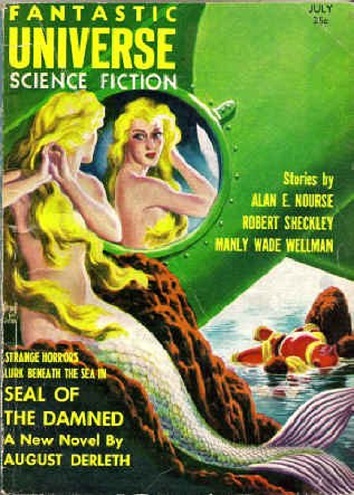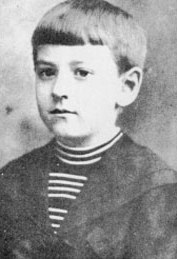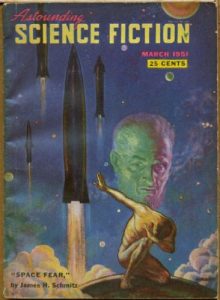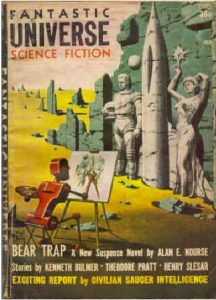Greetings all
I have to say, I’m really enjoying the new schedule so far. Doing the magazine reviews on Thursday or so meant I was reading the mags in the middle of the week, which is my most productive writing time. Now, they’re a weekend reading treat and writing the review is a nice Monday warmup for my writing.
Anyway, this week I’m reading the Fantastic Universe from July, 1957. This is another cover I wouldn’t mind seeing made into a poster. In general, I love the art in these mags, even though I know it’s usually not transcendent or legendary. It is, however, vibrant. I’m still the guy who was at the Hermitage in St. Petersburg ignoring a da Vinci because there was a table showing a seascape mosaic of lapis, malachite, and other semi-precious stones. Incredibly beautiful.

Table of Contents: http://www.isfdb.org/cgi-bin/pl.cgi?89841
Anyway, enough about my weird tastes in visual media, let’s get right to August Derleth’s Seal of the Damned. After all, Cthulhu isn’t going to wake himself up.
Derleth was a prolific writer in general. I didn’t realize until I looked at his Wikipedia entry just how much he’d written. I suspect I’ll have to track down some of his other things now. Anyway, he was a friend and correspondent of HP Lovecraft and continued the Cthulhu stories, despite some criticism from other correspondents of Lovecraft. If you’re a fan, you already know all that, but have you seen the picture of HP Lovecraft when he was about 9?

If you’re a fan, then you’ve also probably seen Seal of the Damned under the title Seal of R’lyeh. The story centers around Marius Phillips, who has always felt the call of the sea, despite his parents, who never let him go east of Ohio.
Then his eccentric uncle Sylvan died, leaving all he had to Marius. This included property in Innsmouth, Massachusetts on the coast of the sea. He finds that his uncle had “interesting” tastes in art and literature. He also finds that his family has been long connected to the Marshes, whose remaining member is the oddly attractive Ada.
He offers her a job as a housekeeper, which she accepts with a bit too much enthusiasm. He discovers her searching the house for something. Rather than confronting her, he too searches for the something, which turns out to be his uncle’s papers, journals, and notes, including “In his house at R’lyeh, dead Cthulhu waits dreaming.” It also includes interesting details about an aquatic race. Humans, but ones who can live underwater and build cities like R’lyeh.
The call of the sea that Marius has felt all his life is all the more greater now that he’s at his uncle’s house. His uncle’s notes talk about investigating the sea all around the house, and when he discovers the secret passage his uncle took to reach the ocean he has no choice to explore.
He gets diving equipment and starts exploring, but he’s pulled by that desire to go to the sea far past its oxygen endurance. Just when he’s about to die, Ada swims up without any gear, rips off his helmet, and he discovers that they are descended from the aquatic race.
Now the pull shifts. He now wants to find the hidden city R’lyeh, as does Ada. According to his uncle’s notes, it’s near Ponape, and the two travel there. In the end, they find the lost city and are not seen above the ocean ever again.
I liked this story quite a bit, but it could have been improved. The high-quality building of tension in the early portion of the story sort of faded away into exposition at the end. Once he is saved from drowning, which was 20 pages leading up to that crisis, there are 3-4 pages of them spending weeks in Ponape and eventually disappearing. The story would have been stronger if it ended right after the crisis, leaving him wondering about what to do next, and not so casually glossing over the entire adventure to find the city.
Next is a really good story by Alan E. Nourse called The Native Soil. Side note, I can easily tell what others think about a story simply by looking at it’s ISFDB entry. Good stories are often reprinted, as was the case for both The Seal of the Damned and The Native Soil.
The Native Soil uses one of those iconic SF pulp tropes. Iconic planet promises something of great value. Humans try to get that something, but for some reason, they’re not as successful as they ought to be. Troubleshooter is brought in, eventually identifies the problem and comes up with an elegant solution.
I love this trope, so I liked this story. We discover the surface of Venus is essentially mud, often many feet deep. There’s a type of that mud, however, that has an antibiotic especially useful for new medicines because it’s not creating resistant strains of diseases.
However, the pharmaceutical company trying to get that particular mud is finding it extremely difficult. There’s no way to do it all without the help of the Venusians, but they seem incredibly stupid. No matter how well things are described to them, they keep making mistakes that destroy equipment and halt production. They’re nice, happy, and try to be helpful, but they just aren’t smart enough.
That’s when the troubleshooter is brought in. At first, he keeps getting caught in the cycle of trying something and having it fail because the Venusians just can’t do their part. However, he also keeps remembering the intelligence test applied to the alien species soon after first contact. This test says they’re plenty intelligent enough, despite appearances.
He realizes they’re intelligent enough to sabotage their harvesting process. The special mud is, essentially, their food source. They eat antibiotics. His elegant solution is to trade penicillin, which isn’t as valuable as a medicine but still easily produced on Earth, for this mud, which the Venusians would harvest themselves to exchange.
I like elegant solutions of that sort.
The next story is The Machine by Robert Sheckley. This is a typical Sheckley story in that it has a good twist at the end, one somehow driven by the foibles of man.
The protagonist, Otto, a valued machinist for years, the kind of stolid employee that at the time would be expected to stay at a company all his life, comes in one day and quits. Not only does he quit, he tells the bosses exactly what he thinks of them, spits on the floor and leaves.
With that bridge burning nicely, he returns home. He is ready to build the “wishing machine” designed by his partner. It’s a machine that will essentially convert any mass, including air, into whatever is asked for. A philosopher’s stone that provides anything, not just gold. The partner told him the day previously that his design was complete, so Otto quits his machinist job to build the machine.
However, the partner wasn’t actually ready for that step. There’s still something wrong, a basic flaw in the design. However, the partner assures Otto he’ll have it ready in a few more months.
Otto’s heard that before, though, and he’s grown impatient. He feels the partner isn’t ever going to say the design is right and, even worse, would want to show other scientists what he’s created. So Otto kills him and makes the machine off the completed blueprints.
After many months of work, selling all he had for food, parts, and tools, then selling the unneeded tools, he manages to make the machine. At the end, he’s exhausted and hungry, but it’s done.
His first request is humble, a loaf of bread. Butter would be nice, but the bread would be just fine. However, the machine puts out pieces of metal, including gold. It’s a nuisance, but with gold he can go get bread… until the machine stops him.
The basic flaw is that it’s what the machine wishes for that matter, not the operator. And the machine wishes to be his sole owner, and last we see, he’s reaching for Otto. As I said, good story. Otto gets what he deserves, and we’re left with some curiosity of the fate of humanity.
Immediately after is a microstory. I have no better idea what to call it that that. It fits in about 2-3 inches at the bottom of the page and is uncredited. It asks one question. If you’re a robot and you must not harm a human, what would you do if you knew you were about to be replaced? Asimov’s first robot story is published in 1939, so this question wasn’t new, but it’s starkly phrased. What would you do?
The next story is A Candle for Katie by Lila Borison. As far as I can tell, this is the only thing she ever published, which is too bad. I found a reference to her in an article by Sam Moskowitz. In it he talks about the first science fiction class ever taught, which started in March of 1954. Moskowitz kept track of his students, and says of her, “Lila Borison, a receptionist who had been reading science fiction for five years and had written for her college newspaper. She was more interested in straight fantasy.” (Sam Moskowitz. “The First College-Level Course in Science Fiction.” Science Fiction Studies 23, no. 3 (1996): 411-22. http://www.jstor.org/stable/4240549, 417).
A Candle for Katie tells of a harried mom who’s hosting the first birthday party for her daughter Katie. Among the gifts she receives is a candle, notched 21 times, with the instruction to light it each year on her birthday, stopping it at each notch.
A strange gift, perhaps, but I for one would find such a tradition a fun one. So, in the midst of the chaos created by a party that included more kids than expected, it comes time for the cake. The mom adds the candle, but Katie has had enough and it’s time for a nap. The mom takes care of that, then deals with a boy who had gotten a hold of a knife and cut himself, and other disasters.
With a sigh, she goes in to check on Katie and she finds a girl of about 5 or 6, but no sign of Katie. Then, the girl looks up and the mom recognizes her eyes. She had left the candle burning, and it was nearly to the fifth notch.
Cool and creepy, especially since Borison left it hanging right there. We are left to wonder about all the things of what happens next, especially since we never know who sends the candle. Excellent work. I do wish she’d kept writing.
I do also wish the next authors hadn’t kept writing. I’ll admit I glossed over the essay here, which is written by Alexander Mebane, Isabel L. Davis, and Ted Bloecher, the Civilian Saucer Intelligence. For 17 issues, they submitted a list of the various potential UFO sightings they could track down. I suspect I might have enjoyed these essays in 1957 as collections of quirky tidbits, but looking back over 60 years, these mostly bore me. Perfectly appropriate content for the magazine, but these essays didn’t age well.
John Healy, much like Lila Borison, only published the story in this issue. It’s called the Book of Goots, and while it’s not as strong as A Candle for Katie, it is a good story. It’s about a small-time hoodlum who comes across a book that purports to teach someone how to use magic. Not the simple prestidigitation of a showman, mind you, but real magic. Goots doesn’t figure he has much to lose, so he reads it.
About the only thing I know about Healy is in the small blurb ahead of that story, which says he was mind reader and mentalist. Obviously, this is a case of write what you know.
Anyway, Goots is your typical hood, but he’s making enough on the magic gig to essentially be straight. The cops don’t believe it, of course, and Detective O’Flahirty sends Abigail in undercover to find out just what racket Goots is working on.
He suggests she pose as his sister, whose husband has died, to get into one of Goots’s seances. He does this in part, because he’s in love with Abigail, and this makes her slightly closer to him.
But this backfires because Goots really can do magic, and the brother-in-law appears, naked of course, grumpy because he’s in the middle of quality time with an Egyptian girl named Cleo. He tells everyone there that Abigail isn’t his wife and to let me get back to what’s more important to him right now.
In the ensuing kerfluffle, Abigail and Goots eventually discover they’re in love with each other. In the end, they fly off on a flying carpet improvised from a hospital sheet. O’Flahirty, for his part, gets admitted into the asylum as he apparently thinks he’s a cop chasing after said flying carpet.
It’s a cute, whimsical story made all the more fun by Healy’s use of language. It’s filled with the sort of slang we imagine from a 40s-50s hood. It’s too bad this is the only Swami Goots story, because they had a lot of potential.
Backward Turn Backward by Dorothy H. Edgerly is next. She, too, didn’t write much, just two stories that I can find. These star Jeb Enders, a warlock living in Appalachia. His village is essentially all witches and warlocks, living on the mountains for centuries. Enders is a regular troublemaker, one who has been told by their council never to interfere with humans again, never to use his magic on the mountain again.
Now, the future has come in the form of a factory looking to build a plant in the valley beneath them. This would force the entire collection of witches and warlocks living on the mountains around it to move.
This proposal would greatly harm the mountain folk, but Enders can’t simply use magic to drive progress away. He begins by looking at the valley and starts asking why it is why it is. He starts going back in time and finds that it was a lake fed by a large waterfall. Now it’s a creek, with soggy land around it every spring, fed by a small waterfall. He hunts through time to discover that it used to be fed by a spring that got blocked by a boulder, turning the large waterfall into the small one and leaving the lake to go away.
With help to do the magic he isn’t allowed to do, he cleans the dirt around the boulder and then lifts it away from the spring. It begins to run as it did before, and soon the lake with return, meaning the factory has to be elsewhere.
It’s a good story and Jeb’s a fun character. It’s got a bit of Avatar in it, though, with stock factory boss bad guys. It’s definitely got that trope of nature being awesome and civilization being awful. However, while Avatar uses amazing visual effects to distract you from a wretched story, Edgerly writes a good story with a solid puzzle and challenge to overcome faced by characters you want to succeed.
We know the next author, though not by the name of Lee Correy. This was the pen name for G. Harry Stine and his Landing for Midge is the next story. A ship coming to earth has been hit by a microasteroid which has knocked out its landing radar. Not only will they have to have a manual landing, one of the passenger is Midge, a pregnant woman.
Stine was a rocket scientist and this clearly shows. He throws in appropriate technical jargon here and there, but more importantly, the main question to the this story is how free-fall would affect pregnancy and birth?
What a fascinating question to ask three months before Sputnik launched.
Anyway, at first, the landing control people at White Sands try to divert the ship to an orbit, there to await the transport of a new radar, allowing the computers to land the ship properly. Again, this is written before Sputnik launched, yet the bulk of the science in this story still feels right.
The manage to make it to land just before Midge, who is in labor, gives birth. They roll up to the landing spot where emergency personnel are waiting. They rush up to the ship.
First on, of course because of Midge, is the vet.
Cats, you see, are the only other terrestrial creature to take to free fall at all. In fact, many seem to love it. Ship crews definitely love having them along, and let Midge come along because she insisted.
She didn’t need any help, by the way. The vet finds her with three cute, healthy kittens, all born during the landing.
Yeah, I loved this story.
Voyage Beyond the Night by John Victor Peterson follows, and it is another of the short, sharp excellent stories in this issue. It starts with Ken Chapman cracking a tomb in the Great Pyramid.
Currently, Chapman’s reputation is ruined because he was supposedly the researcher for a best-selling historical novel on pharoahs that doesn’t get most of the facts correct. The book is written by Eric Stromberg, who is a reclusive genius much like Elon Musk.
When he opens the tomb he finds the second of Khufu’s soul ships. And something else. He rushes back to Stromberg hastily, asking if he’ll write a sequel. Stromberg says he will.
At that point Chapman leaves. He realized then he could never show Stromberg the item he’d found in the sealed tomb. It was a Stromberg Electronics Temporal Traveler, and Stromberg was headed to his death.
We get another pen name next: C. Bird. It’s actually Harlan Ellison and the story is Song of Death. Again, a short, sharp story, this one the cover story.
There is a planet where mermaids live. People would pay a pretty penny if someone could bring a mermaid from the planet back to Earth, but though many had tried, all of them had died. Like the Sirens of the Odyssey, the mermaids can sing a song that lures all to death.
However, this adventurer believes he can see. He’s tried many get-rich-quick schemes before, but he’s sure that this time, this time he’ll get al the money he’ll ever need.
Oddly, he’s right. He manages to land without dying, though the landing wasn’t pleasant. He manages to coax a mermaid close, stun her, fill a hold with water, and bring her back.
He’s tone-deaf and their song doesn’t affect him. Such a Harlan Ellison ending.
Lloyd Arthur Eshbach is next with The Fuzzies. Eshbach, as you may know, was a fairly important person in the early days of SF. He published his first story in 1929. In the 1930s, he was the editor of a couple of magazines, and then in he founded Fantasy Press. The list of authors and books published by it is impressive. However, it went under in 1956, so about a year before this story at a time when he needed money.
Again, another good story. This one involves miners on Ganymede. There are crystals on Ganymede that the Fuzzies desperately want. The Fuzzies are telepathic little balls of fur who can work with humans. However, they can only work with likeable humans. No criminals, none who are violent, nothing like that. They leave humans who stop being likeable by committing suicide.
Which makes the hero, Herb, all the angrier. He and two others had filed conflicting claims on rights to some crystal fields. One had dropped out, saying he was satisfied. Herb and Swain, however, had ended up in a duel. The thing was, Herb realized in the middle of the duel that his gun had been emptied.
Now he was on the chase for Swain to give him what he had coming.
He finds Swain in his portable shelter with the help of his Fuzzy. Swain has no gun, Herb doesn’t feel right shooting him without a gun, so he tells Swain to fight. Swain tries, but immediately passes out. He had a broken leg and would like die without Herb’s help.
Which, of course, Herb does. He brings back Swain to Center City. Along the way, he discovers that Swain hadn’t been the one to remove the ammunition, but rather it had been the other guy in hopes of getting all of his disputed claim.
But Herb brings Swain to the hospital, then files his claim, one of the richest. He actually files a joint claim with both he and Swain. That’s when he finds out Swain had also filed a rich claim. Also joint. Also in both of their names.
The Fuzzies only stay with likeable men.
Finally we get to the last story, one I’ve been looking forward to. It’s Fiddler on Titan by Manly Wade Wellman. Wellman is of particular interest to me since he and his brother, Paul Wellman, were Wichita boys and good writers. Fellow Wichita State alums. Here’s an interesting blog post on Wellman by David Drake: http://david-drake.com/2010/manly-wade-wellman/. The two became friends in 1970.
In any case, the story was worth my anticipation. Fiddler on Titan is about the first expedition to Titan, Saturn’s “biggest and only habitable satellite” (120). Expedition A includes 14 men and women. They arrive to find out that one of them, Ham, has brought his family fiddle with him in contravention of the rules and ignoring the effects that its weight might have on the trip.
But they made it and find a plain with vegetation and a big lake. The set up as pioneers in sort of a Little House on the Prairie fashion awaiting Expedition B in something like 18 years. Fiddles and music were important to those pioneers, and even more so to these on Titan.
For Titan held alien life, intelligent life, in the form of amorphous blobs who could take just about any shape they wanted and create any tool they needed. Ham played his fiddle and realized that if he played songs that made him think of dancing, they’d dance, or leaving, they’d leave, or working, they’d work. The Titanians and these first humans became allies.
But space is not without dangers, especially human dangers, and a pirate band comes to call. They landed, watched Expedition A, and come to take over. They know that Ham playing the fiddle gets the Titanians to work, but they don’t quite know how. They tell Ham to play, which he does, but instead of a song he’d played before, he plays a war song. The Titanians connect to song and thought and shoot the pirates.
Man, how many good stories are in this issue. The only downer was the UFO essay, and that’s easily skipped over. This is a 9.5 and would have been a 10 with a good essay and one of my favorites.
It even has a fantastic ad on the back cover. It says “Take this Lunar Quiz and win a round-trip reservation to the Moon. Free!” It’s a fantastic ad for the Science Fiction book club.
Next Week’s Issue: http://www.isfdb.org/cgi-bin/pl.cgi?57435
Thanks for readings. Next week I’ll review the Astounding from December, 1945.
If you have any comments or would like to request I keep my eyes open for a specific issue or month, feel free to comment here or send an email to me at: rob@robhowell.org.
If you want to see previous reviews, the Mag Review category is here: https://robhowell.org/blog/?cat=432.
Have a great day.
Rob Howell
Author of the Shijuren-series of novels
- Website: www.robhowell.org
- Patreon: https://www.patreon.com/rhodri2112
- Blog: www.robhowell.org/blog
- Shijuren Wiki: http://www.shijuren.org/World+
of+Shijuren+Home - MeWe: https://mewe.com/i/rob.howell1
- Facebook Author Page: https://www.facebook.com/robho
well.org/ - Twitter: https://twitter.com/Rhodri2112


